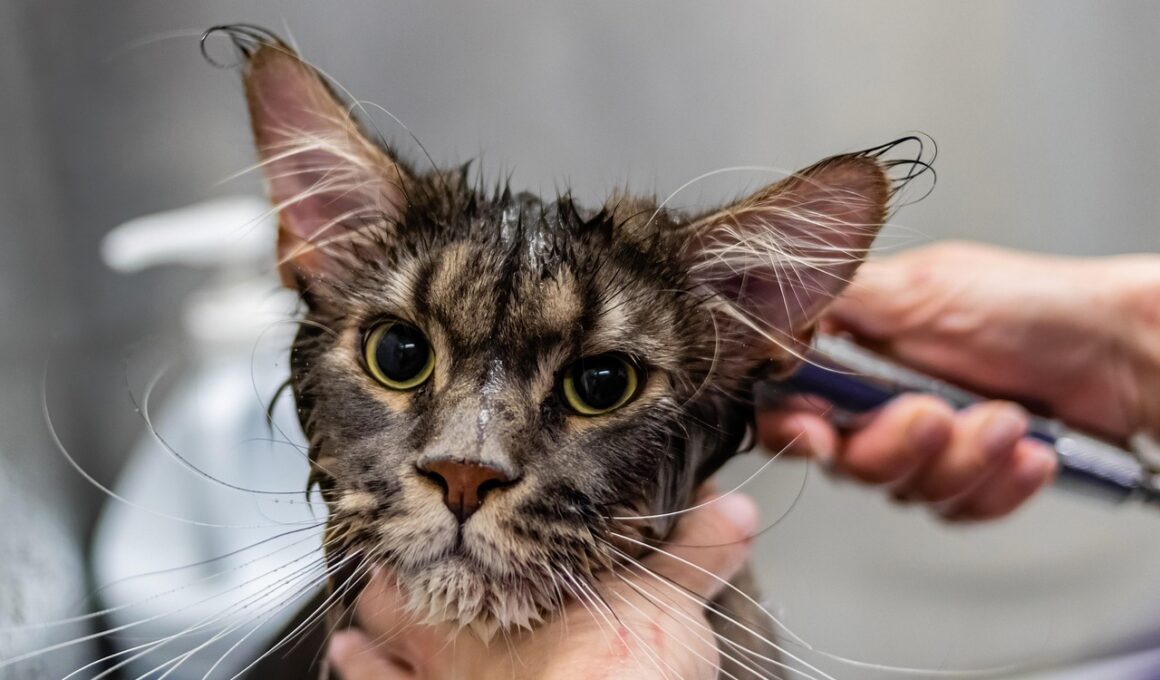How to Introduce Your Cat to Bathing Gradually
Bathing a cat can be a daunting experience for both the owner and the feline. Gradually introducing your cat to bathing helps to alleviate their fears and promotes a more enjoyable interaction with water. Start by creating a positive environment where your cat feels safe and secure. Set up a comfortable bathing space, and let your cat explore it at their own pace. Reward them with treats and affection whenever they show interest in the tub. By building a positive association, you encourage curiosity and reduce anxiety. Additionally, consider using a non-slip mat to prevent them from sliding during the process. Always remember to speak in a gentle, soothing tone, as this can ease their apprehensions significantly. Patience is a virtue here; rushing the process will only increase stress levels. Over time, introduce your cat to small amounts of warm water using a cup or a sprayer. This slow approach allows cats to adjust gradually. Be attentive to their body language while experimenting. If they appear distressed, take a step back and repeat the previous steps until they show greater comfort.
Once your cat exhibits signs of relaxation around water, it’s time to go a step further. Start with shallow water in the tub, filling it just enough for them to feel the sensation without overwhelming them. As they adapt, increase the water level gradually, ensuring they always feel in control. Consider using lukewarm water, as extreme temperatures can cause discomfort. Use an appropriate cat shampoo to ensure their skin remains healthy and free from irritation. Before splashing your kitty, familiarize them with the shampoo by applying a small amount to the back of their paws. Allow them to smell and feel the product, reinforcing the idea that bathing is a non-threatening experience. Be gentle as you apply water with a cup or spray, taking care to avoid their ears and eyes. Maintain a calm demeanor throughout the process. Praise and reward your cat. Remember, comfort and positivity are vital. Establishing a routine can help; regular bathing every few weeks will reduce the likelihood of fear. Additionally, engaging your cat with toys during the process can redirect their focus onto something enjoyable, creating a fun bathing environment.
Preparation for Bathing
Proper preparation is key to ensuring a smooth bathing experience for your cat. Before starting, gather all the necessary supplies, including cat shampoo, a towel, a non-slip mat, and a brush. Having everything ready allows for a more seamless process and minimizes the chances of your cat growing impatient or anxious. Consider brushing your cat beforehand to eliminate excess fur and reduce tangles. This extra step makes bathing more effective by preventing matted hair. It’s wise to ensure your cat’s claws are trimmed to avoid any accidental scratches, as their instinct may lead to resistance during bathing. Use a cat harness if necessary, especially for particularly wriggly felines. Be sure to create a warm environment in the bathing area; you can close doors and windows to reduce drafts. Having the room free from noise also contributes positively to their comfort. Allow your cat to explore the area before bathing so they can familiarize themselves. It’s important not to force them into the tub; respect their boundaries. Doing so creates a more positive and trusting atmosphere. Tailoring the environment sets the stage for a successful experience.
During the bathing session, attention to detail can greatly enhance comfort levels for your cat. After placing your kitty gently in the bathing area, reassure them with a calm voice. Begin by wetting their body with warm water, avoiding their head. Some cats may react negatively, so take your time. Patience is essential. Slowly apply cat-friendly shampoo, lathering gently through their fur. Be cautious to avoid their eyes, ears, and mouth, as these areas can cause distress if water or shampoo comes into contact. If your cat displays signs of distress, take a moment to pause and comfort them. It is critical during this phase to ensure the experience remains as positive as possible. If you notice your kitty becoming agitated, consider stopping the session and trying again later. Each step should reinforce trust and familiarity with bathing. After rinsing off the shampoo thoroughly, gently wrap your cat in a soft, warm towel to keep them cozy and prevent them from becoming too cold. Dry them sufficiently, but be aware that some cats may not enjoy this part. Always allow them the chance to dry off naturally if they prefer.
Post-Bathing Care
After bathing, ensuring proper follow-up care is crucial for your cat’s happiness and health. Upon finishing, it’s beneficial to shower your kitty with affection, reinforcing the idea that bathing can be a pleasant experience. Offer a favorite treat or a toy once the session is complete. This creates lasting positive associations. Monitor their behavior in the following days, noting any signs of stress or anxiety. If your cat continues to show signs of discomfort regarding bathing, consider extending the intervals between baths or revisiting the gradual introduction process. Regular grooming outside of baths can also help maintain coat health, reducing the need for frequent washings. Schedule bathing during warmer months; dry fur dries faster and more comfortably. If your cat becomes resistant, be prepared to backtrack in your approach. Each cat’s temperament is unique, and adapting to their needs ensures a more positive outcome. Consulting with your veterinarian may provide additional insights or tips tailored to your specific feline. Emphasizing care and attention post-bath fosters trust and encourages your cat to feel more relaxed about future sessions.
Remember that every cat is different, which means the pace of introducing bathing will vary among individual felines. Some cats may quickly adapt, while others require a slower, more supportive approach. Be observant to understand their limits and comfort levels. Keeping the bathing sessions short initially prevents overwhelming your cat, avoiding distress or panic. As you repeat the bathing experience, gradually extending the length may promote better adaptation over time. Creating a calming environment by playing soft music or using pheromone diffusers can also support relaxation. Moreover, consider using treats and rewards throughout the process to reinforce good behavior. This creates a joyful atmosphere that encourages consistency. It’s essential to stay balanced and not create fear surrounding bathing; avoid stressful interactions. Celebrate small victories, and be patient. Over time, most cats can learn to tolerate or even enjoy bath time, fostering a stronger bond between you and your pet. Remember that the goal is not just cleanliness but also establishing trust and comfort in the process. Understanding your cat’s body language provides insight into their feelings and readiness. Ultimately, cooperation should be the aim.
Additional Tips for Cat Bathing
In addition to the methods discussed, there are some additional tips that can streamline the cat bathing process. Perform the bath during a time when your cat is naturally relaxed, such as post-meal time or after a long play session. This will make the whole experience smoother, as they’re more likely to have calm energy. Additionally, consider using a spray nozzle rather than a cup for wetting to gain better control and minimize splashing. Ensure that both you and your cat are safe by placing a towel underneath their paws to prevent slipping. Using treats specifically given during the bath can be an effective method of distraction, helping your cat disengage from anxiety. Furthermore, consider preparing them with a bath similar to a spa experience. This can include gentle handling or playing soft water sounds, enhancing the relaxation factor. Remember also to supervise any other pets if they tend to be curious or combative. Be mindful while using a hairdryer; some cats may not appreciate the sound or feel of it, so always proceed with caution. Most importantly, keep reinforcing positive behavior with praise throughout the process.
To maintain safety precautions, ensure all bathing supplies are safe and suitable for use on cats. Human shampoos and soaps can irritate their skin. Always choose products designed for felines, ideally recommended by veterinarians. Do a patch test for any new product before applying. Should you notice signs of adverse reactions, discontinue use immediately and seek guidance from a veterinarian. Consider keeping sessions and products consistent every time to avoid sudden changes that may confuse your pet. Each bath strengthens the bond between you both, but communication is key. If your cat signals discomfort, never force them; this will create a negative experience and may affect future bathing attempts. After each session, take a moment to give them a calming massage or quality playtime. This reaffirms trust while also normalizing post-bathing interactions. For cats that resist baths entirely, consider exploring alternatives, like waterless shampoo. However, you should approach this with a gradual introduction for successful acclimatization, just as you would with regular bathing. Building a positive routine with bathing will turn it into a more manageable part of your feline’s care.


